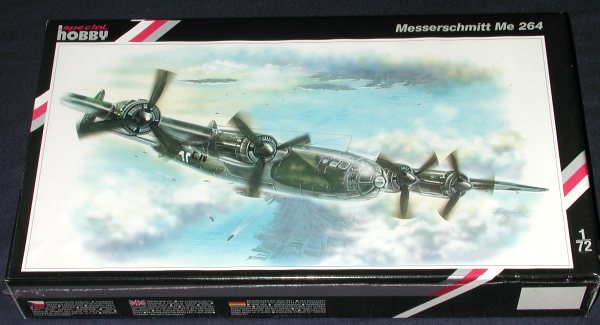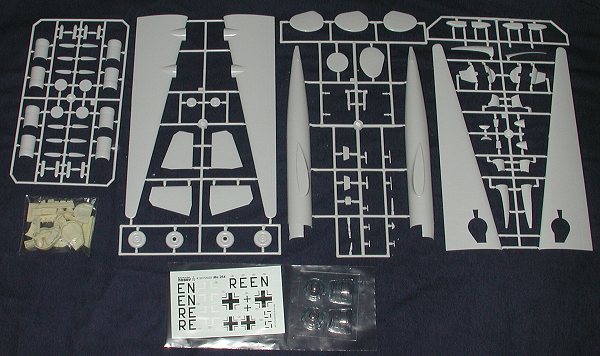
|
KIT: |
Special Hobby 1/72 Me-264 |
|
KIT # |
72025 |
|
PRICE: |
AUD$50.00 |
|
DECALS: |
One aircraft |
|
REVIEW & |
|
|
NOTES: |
Short run with resin and vac canopy |

|
HISTORY |
Early in WWII a request was made of the various manufacturers of the possibility of designing an aircraft that could fly to the US and back non-stop. A rather daunting proposal at the time, but designers love such things and responses were received from Focke Wulf with the FW-300 a modification of their planned airliner, Junkers with a modified Ju-290, and Messerschmitt with a brand new design, the Me-264. The 264 would gain range by sacrificing bomb load and defensive armament in exchange for increased fuel load. The RLM went for it and so a low priority order for three planes was made.
In November of 1942 the first prototype, used just to test aerodynamics, was flown using Ju-88A-4 engines and nacelles. It was an ultra clean design with very long wings, similar to the B-24, so it could get the kind of range needed. The only really different part of the design was the nose wheel, something not normally found on aircraft of this size at this time.
By this time the US had entered the war and an 'Amerika Bomber' was needed. The quickest way to get one was to modify the Ju-290 into the Ju-390 by adding two more engines so that was the chosen proposal. The Me-264 wasn't abandon and the other two prototypes were to be used as a basis for a long range reconnaissance aircraft.
The basic change from bomber to recce bird were basically to simplify the design and to use BMW radials in place of the Junkers in-line engines. Prototype v2 was so modified and ready for flight in late 1943 when it was destroyed in a bombing raid. The third prototype was to be the first production bird, but by mid-1944 the need for the plane was really gone and so all development work was stopped.
The Me-264v1 had by that time been placed into Transportstaffel 5 along with other very large aircraft like the Ju-290, Ar-232 and Piaggio P.108T. As with many large aircraft, it was finally destroyed on the ground prior to the end of the war.
|
THE KIT |

Well, let us count the number of injected, 1/72 scale four-engined, prop driven, WW2 German aircraft that are available. I can only come up with the FW-200 Kondor. If you want to stretch things, you can also count the He-177, though its twinned power plant actually only counts as a single engine.
I'm really a sucker for these kinds of kits. Not the limited run ones, but those that are of prototype or very low production aircraft. The Huma Ju-288 is an example of this kind of kit. There is something about these aircraft that is appealing. Maybe it is because they are not something you see every day. It certainly isn't because of the number of different camo schemes and markings you can do them in!
This is probably one of the largest 1/72 kits produced by Special Hobby or any other of the MPM companies. As you can see, the wings are as long as the fuselage so finding display space for this baby will be fun! However it is typical of the genre in all respects with lots of resin and vac canopies. In fact, this one comes with two of them, for which I am very grateful. Hopefully this is a trend. Most of the resin is for the interior, wheel wells, prop spinners and engine fronts. Detailing is of the fine engraved variety and the large bits have ejector marks to remove, but we've seen all this before.
Because of the size of the kit, the instruction booklet is a bit larger than normal and covers 18 construction steps. One note is that the model will require 60 grams of weight to prevent tail sitting. This is not a small amount and cramming it all ahead of the main gear will be tricky as the distance between the nose gear and main gear is small.
There is only one marking option and that is for the only one that flew, RE+EN, the prototype. It is in the standard bomber splinter camouflage scheme of RLM 70/71 over RLM 65. Get out the masking tape for this one! The decals are very well printed and thin so should go on quite well. The swastikas are the usual broken ones so perhaps a set from the spares box might be in order.
A closing note on the box. This particular box comes factory sealed so that you can only open one end. Frankly, I like this. Not as nice as a two piece box, but it certainly helps to keep any loose parts from disappearing out of the cracks once the parts are taken out of the plastic bag.
|
CONCLUSIONS |
It never ceases to amaze me what interesting Luftwaffe subjects are being produced today by various kit makers. Obviously the market for such things is still quite strong, judging by my eagerness to scarf up a copy once I saw it available. One of these days, these guys will discover the prototypes of other countries and do something like an XB-28 or an XB-21 or even a B-18 or B-23. Heck, MPM could use parts from its DC-2 kit to do the last few.
If you would like your product reviewed fairly and quickly by a site that has over 100,000 visits a month, please contact me or see other details in the Note to Contributors.